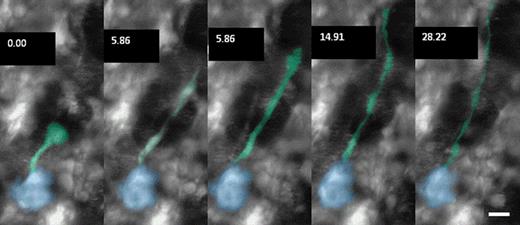Abstract
Abstract 2300
The derivation of blood platelets from bone marrow (BM) MKs has been known since 1906, and it evoked long dispute for the process of platelet production between proplatelet model and platelet territory model. The proplatelet model, in which MKs extend long thin protrusion into the sinusoidal lumen and the tip of proplatelet then bud off, is supported by the images from in vitro cultured MK and fixed BM tissue. The platelet territory model, in which MK cytoplasm is divided by the membrane system into future platelet territories, is supported by the images by electron microscopy from fixed BM tissue.
However, the process of platelet production in vivo remains still enigmatic, because no one could visualize clearly the platelet production from MK in intact BM. Recently, Junt T et al.(1) revealed that MKs routinely release heterogeneous large particles into sinusoids in BM, but their images did not capture the typical long thin proplatelets in sinusoidal lumen using intra-vital microscopy. In this study, we visualized the fine structure of MK protrusions in sinusoidal lumen to reveal the detailed process of platelet production in intact BM of mice skull using intra-vital microscopy.
Two- photon microscope was used to focus on the MK protrusions in sinusoidal lumen of anesthetized green fluorescence protein-transgenic mice to visualize the dynamic platelet production in details. The obtained sequential images were reconstituted as the time-lapse movie, and analyzed in the shape and size of protrusion with the relation to dynamic velocity. To confirm the phenomena captured with the live images, scanning electron microscopy (SEM) was used in fixed BM samples.
The time-lapse live images clearly revealed that MK released two types of protrusion into the sinusoidal lumen. One was elliptically-shaped protrusion, followed by typical proplatelets in the sinusoidal lumen (Figure 1). The proplatelet was released as a thin string into sinusoid, but not discoid individual platelet. The other was a thick string, originated from thick protrusions from MK, into sinusoidal lumen (Figure 2). The thick protrusion clearly differed from the typical proplatelet in the size, releasing point, and dynamic movement to the blood flow.
Using SEM, we could confirm morphologically two types of platelet production, elliptically-shaped protrusion, followed by typical proplatelets and platelet territory structure in the cytoplasm of thick protrusion.
To evaluate the effect of hydrodynamics on proplatelet formation, we evaluated the elongation velocity of proplatelet in sinusoidal lumen by intra-vital imaging. The mean elongating velocity of proplatelet in sinusoidal lumen was 17ƒÊm/min, which was faster than that in static culture condition (0.8ƒÊm/min), implying that sinusoidal flow accelerated the elongation growth of proplatelet.
Differed from the previous models based on the live imaging of BM in mice (1), our images captured that the MKs extended and released two types of protrusion into sinusoidal lumens, typical proplatelet without platelet territory and thick protrusion with platelet territory. The structure of thick protrusion with platelet territory suggests a possibility that they have a great advantage for rapid and massive production of circulating platelets in the case of increasing demand for platelets.
Proplatelet formation (Figure 1) and thick protrusion (Figure 2) in sinusoid from intra-vital imaging of intact bone marrow in EGFP Tg-mice (megakaryocyte is colored blue and proplatelet is colored green).
No relevant conflicts of interest to declare.
Author notes
Asterisk with author names denotes non-ASH members.



This feature is available to Subscribers Only
Sign In or Create an Account Close Modal